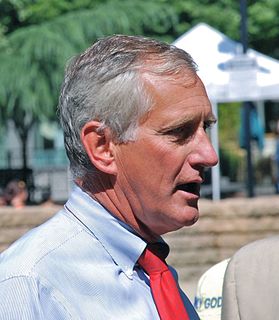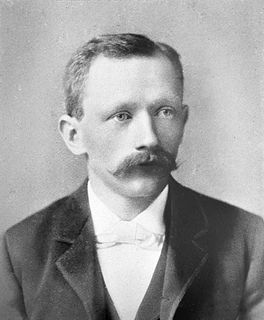
Thomas Jay Potter is a former American politician and law enforcement officer in the U.S. state of Oregon. He served as Mayor of Portland from 2005 to 2009, and had been the chief of the Portland Police Bureau. As mayor he continued his advocacy of community policing and expressed interest in other reforms of the Portland police department. He marched against the Iraq War on the first anniversary of American involvement in March 2004 and was dismayed at the black uniforms and the militarized appearance of the Portland police he saw. He made it part of his campaign to rid the police of such a militarized appearance.
Interstate 405 (I-405), also known as the Stadium Freeway No. 61, is a short north–south Interstate Highway in Portland, Oregon. It forms a loop that travels around the west side of Downtown Portland, between two junctions with I-5 on the Willamette River near the Marquam Bridge to the south and Fremont Bridge to the north.

St. Johns is a neighborhood of Portland, Oregon, United States, located in North Portland on the tip of the peninsula formed by the confluence of the Willamette River and the Columbia River. It was a separate, incorporated city from 1902 until 1915, when citizens of both St. Johns and Portland voted to approve its annexation to Portland, which took effect on July 8, 1915.

Kenton is a neighborhood in the north section of Portland, Oregon, United States. The neighborhood was originally a company town founded in 1911 for the Swift Meat Packing Company.

Dan Saltzman is a politician in the U.S. state of Oregon who served as a commissioner on the City Council of Portland in Portland, Oregon, from 1999 through the end of 2018. As of 2017, he had served longer on the Council than any other person since 1969.

Washington High School was a high school in Portland, Oregon, United States, from 1906 to 1981. After fire destroyed the original building, a new building was completed in 1924. The school merged with Monroe High School in 1978 to become Washington-Monroe High School. The school closed shortly after in 1981, and the building was vacant for many years. In October 2013, plans to renovate the building for commercial use were advancing, with a mix of retail and office use planned. New Seasons Market relocated its offices to the building in 2015 and is the largest tenant. The former auditorium was repurposed as a music venue called Revolution Hall, which opened in February 2015. The building was listed on the National Register of Historic Places in November 2015.

Portland City Hall is the headquarters of city government of Portland, Oregon, United States. The four-story Italian Renaissance-style building houses the offices of the City Council, which consists of the mayor and four commissioners, and several other offices. City Hall is also home to the City Council chambers, located in the rotunda on the east side of the structure. Completed in 1895, the building was added to the National Register of Historic Places on November 21, 1974. City Hall has gone through several renovations, with the most recent overhaul gutting the interior to upgrade it to modern seismic and safety standards. The original was built for $600,000, while the 1996 to 1998 renovation cost $29 million.

The Portland Police Bureau (PPB), officially the Portland Bureau of Police, is the law enforcement agency of the city of Portland, the largest city in the U.S. state of Oregon. While oversight of Portland's bureaus shifts among the five City Commissioners, the mayor has historically been assigned to the Police Bureau as the police commissioner.

Charles Andrew Hales is a former American politician who served as the 52nd mayor of Portland, Oregon, from 2013 to 2017. He previously served on the Portland City Council from 1993 to 2002.

Francis I. McKenna was a real estate and land developer, and architect from the 1890s to the 1920s in Portland, Oregon. McKenna moved to Portland in 1889 and purchased the land now known as the University Park neighborhood. He went on to establish the Portland Belt Line Company, which lobbied city officials to extend the cable car system to St. Johns, Oregon. The project was constructed in 1905. McKenna was also known as an advocate of civic improvement and industrialization.

The Portland Woolen Mills were a wool textile manufacturer in the St. Johns neighborhood of Portland, Oregon. By 1950, they had become the largest wool manufacturer west of Cleveland, Ohio. The origins of the factory started in Sellwood in 1901 but after a fire destroyed the mill two years later owners decided to rebuild in St. Johns. Portland Woolen Mills offered several worker programs including baseball, basketball and bowling teams; a cafeteria and a library.

The St. Johns Twin Cinema, formerly known as the Northgate Theater and the St. Johns Theater, is a movie theater located in the St. Johns neighborhood of Portland, Oregon, United States. It was opened in 1913 by the People's Amusement Company.

James John High School was a public high school in the city of St. Johns, Oregon that later became part of Portland Public Schools after St. Johns was annexed to Portland in 1915. The school opened in 1911 and had four students in its first graduating class. It closed in 1923 after the completion of its replacement, Roosevelt High School. It was named for James John, the founder of the St. Johns settlement.
The St. Johns Racquet Center is an indoor tennis facility located in the St. Johns neighborhood of Portland, Oregon. It opened in 1979 and is owned by the city and managed by Portland After-School Tennis & Education (PASTE). It was previously operated by Portland Parks & Recreation.

Jobes Milling Company was a flour mill based in the St. Johns neighborhood of Portland, Oregon. It was constructed in 1904 by William Van Zant Jobes who relocated to St. Johns from Spokane, Washington. He died in 1907 and his sons took over the mill. In 1910, William Haskell Jobes died leaving sole ownership to his brother Allan R. Jobes. He sold the mill in 1918 and died three years later. The Rose City Flour Mill operated the mill as a subsidiary until the building was demolished in 1930.

James John (1809–1886) was founder of the settlement of St. Johns in Oregon. The area later became a city when it passed a charter in 1902. It was annexed into Portland in 1915. John worked as a general store and ferry operator across the Willamette River to Linnton. He once served as Justice of the Peace and was twice an election judge. John was born in Ohio and first settled in Indiana with his wife and child where John worked as an educator. He joined the Bartleson–Bidwell Party in 1841, who were one of the first groups that trekked the California Trail. By this time, John's wife and child had died. He came to Oregon Country in the employment of the Hudson's Bay Company in 1843 after making it to Sacramento Valley.

Charles Ray Jordan was a Portland City Commissioner from 1974 until 1984. He was the first African-American city commissioner in Portland, Oregon, and is the namesake of the Charles Jordan Community Center.

Henry John Hefty was an immigrant from Switzerland who worked as an architect based in Portland, Oregon, United States.
Starting in May 2020, demonstrations over the police murder of George Floyd were held in the city of Portland, Oregon, concurrent with protests in other cities in the United States and around the world. By July 2020, many of the protests, which had been held every day since May 28, drew more than 1,000 participants. Protests continued into August, September, and October 2020, often drawing hundreds.

The Multnomah County Justice Center, or simply Justice Center, is a building located at 1120 Southwest 3rd Avenue in downtown Portland, Oregon. The building was designed by ZGF Architects. It is adjacent to Lownsdale Square.



















